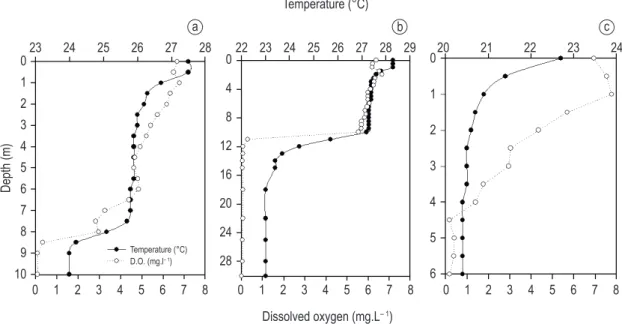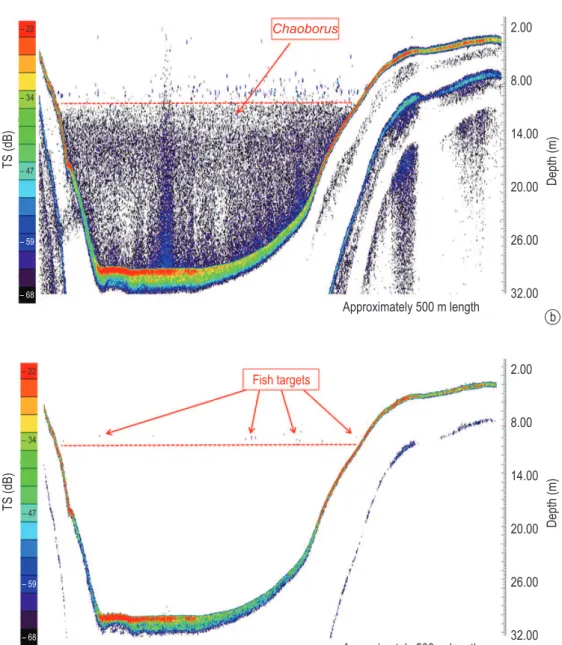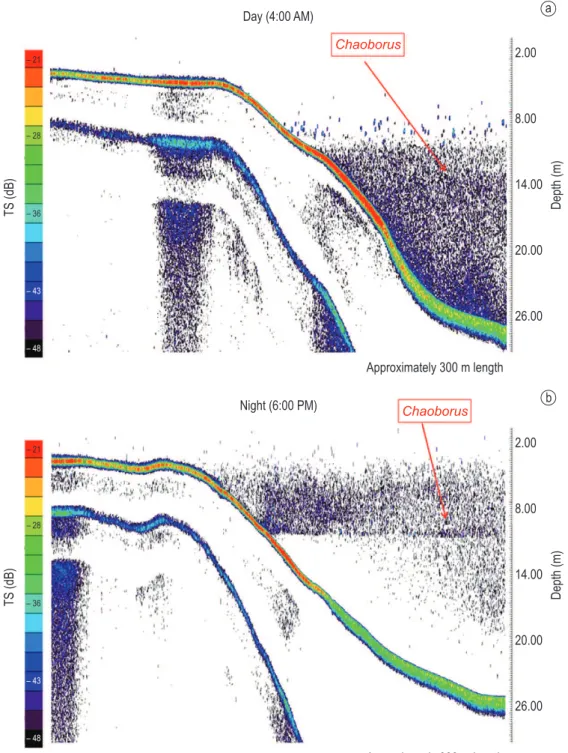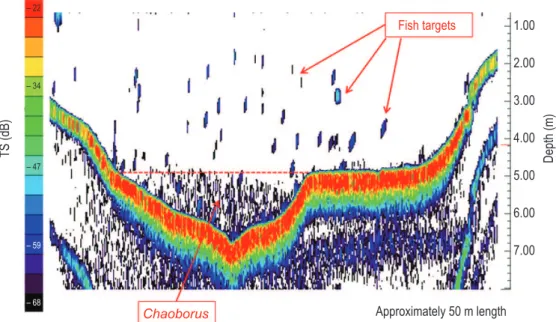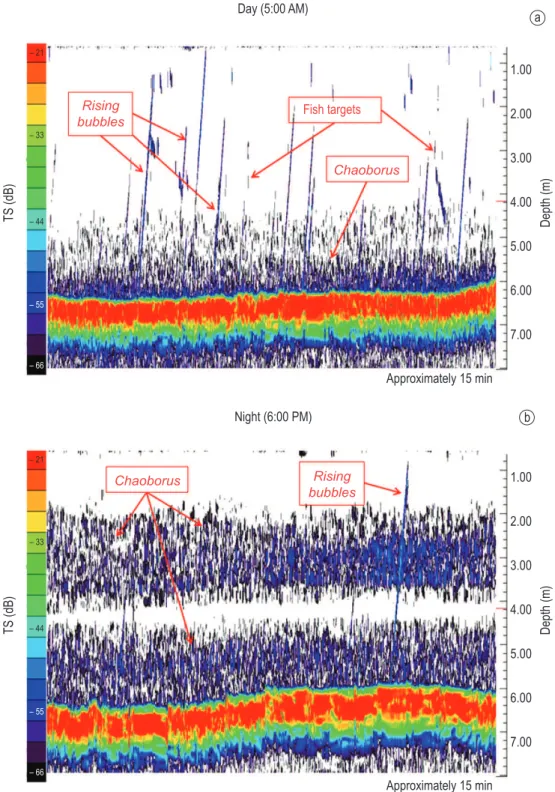Hydroacoustic assessment of fish and
Chaoborus
(Diptera-Chaoboridae) distribution in three Neotropical lakes
Avaliação hidroacústica da distribuição de peixes e
Chaoborus
sp.
(Diptera-Chaoboridae) em três lagos neotropicais
José Fernandes Bezerra-Neto1, Ludmila Silva Brighenti2,
Nelson Azevedo Santos Teixeira de Mello2 and Ricardo Motta Pinto-Coelho3
1Laboratório de Ecologia e Conservação, Departamento de Biologia Geral,
Instituto de Ciências Biológicas, Universidade Federal de Minas Gerais – UFMG, CEP 31270-901, Belo Horizonte, MG, Brazil
e-mail: joseneto@icb.ufmg.br
2Programa de Pós-graduação em Ecologia, Conservação e Manejo da Vida Silvestre,
Instituto de Ciências Biológicas, Universidade Federal de Minas Gerais – UFMG, CEP 31270-901, Belo Horizonte, MG, Brazil
e-mail: ludmilasb@gmail.com; nelsonmellobio@yahoo.com.br
3Laboratório de Gestão Ambiental de Reservatórios, Departamento Biologia Geral,
Instituto de Ciências Biológicas, Universidade Federal de Minas Gerais Gerais – UFMG, CEP 31270-901, Belo Horizonte, MG, Brazil
e-mail: rmpc@icb.ufmg.br
Abstract: Aim: This study aims to demonstrate the potential of hydroacoustics in the study of behavior of the invertebrate Chaoborus and fish in neotropical water environments; Methods: Synoptic campaigns were conducted in May and June-2008 in Dom Helvécio and Carioca lakes, at the Parque Estadual do Rio Doce (MG), and Nado reservoir, Belo Horizonte (MG). The acoustic scattering of targets was studied using a downward-oriented split-beam 200 kHz echosounder; Results: We detected clear echo signals from fish and Chaoborus larvae, which can be viewed in high density in all environments studied. The normal migratory behavior of the larvae of Chaoborus could be easily monitored in the Dom Helvécio Lake and the Nado reservoir. However, this behavior was not seen in Carioca Lake; Conclusions: This study revealed the potential application of acoustic approaches to study the behavior of fish and zooplankton organisms in freshwater aquatic systems.
Keywords: echo-sounding, Chaoborus, vertical distribution, fish, zooplankton.
Resumo: Objetivos: O presente estudo tem como objetivo demonstrar as potencialidades da hidroacústica no estudo do comportamento do predador invertebrado Chaoborus e de peixes em ambientes aquáticos tropicais; Métodos: Foram realizadas campanhas diurnas e noturnas em maio e junho/2008 nas lagoas Dom Helvécio e Carioca, no Parque Estadual do Rio Doce e no reservatório do Nado em Belo Horizonte (MG). O espalhamento acústico dos alvos foi estudado utilizando-se uma ecossonda com transdutor digital “split-beam” de 200 kHz direcionado verticalmente para o fundo do lago; Resultados: A ecossondagem nos permitiu detectar eco-sinais claros provenientes de peixes e das larvas de Chaoborus, que estavam presentes grande densidade em todos os ambientes estudados. O comportamento migratório normal das larvas de Chaoborus pôde ser acompanhado facilmente na Lagoa Dom Helvécio e no reservatório do Nado. Entretanto, tal comportamento não foi visualizado na Lagoa Carioca. Conclusões: Os resultados mostrados neste estudo revelaram o potencial de aplicação da abordagem acústica no estudo do comportamento de peixes e organismos zooplanctônicos em sistemas aquáticos de água doce.
Here, we used an echosounder with a high frequency split-beam transducer to determine vertical distribution of Chaoborus and fishes through
qualitative acoustic observations in three Brazilian lentic systems (Dom Helvécio and Carioca lakes, and Nado reservoir). These environments were chosen since they harbor dense populations of
Chaoborus larvae and have been subject of previous zooplankton studies using traditional sampling methods (Fukuhara et al., 1993; Bezerra-Neto and Pinto-Coelho, 2007; Bezerra-Neto et al., 2009).
2. Material and Methods
2.1. Study areas
Nado Reservoir is a shallow, meso-eutrophic reservoir with a surface area of 1.5 ha and a volume of 40 × 103 m3. The maximum depth (z
max) is 7.6 m and the mean depth (zmean) is around 2.7 m. It is located in Belo Horizonte city, Minas Gerais State (altitude 790 m above sea level), in Southeastern Brazil. It has a stable thermal stratification that persists from August to May, with only one circulation period per year during June-July. The epilimnion is well oxygenated, with development of intense anoxia in the hypolimnion during the stratification period (Bezerra-Neto and Pinto-Coelho, 2007).
The lacustrine region of the Rio Doce Valley is the largest Lake District in Brazil. This unique system is located in a dammed valley along the middle course of the Rio Doce River, state of Minas Gerais, Brazil. In this area, there are approximately 130 lakes, 42 of them located within the Rio Doce State Park (PERD), which has an area of 36,000 ha and preserves the largest remaining fragment of the Atlantic Forest in the state of Minas Gerais (Latini et al., 2005). Dom Helvécio is the largest and deepest lake of this region, and is located inside PERD’s limits (Meis and Tundisi, 1997). It is an oligotrophic, dendritic-shaped water body with a warm monomitic circulation type (stratification period between September and May), and highly stable metalimnion (Matsumura-Tundisi and Tundisi, 1995). Carioca Lake is another system located inside the reserve. The lake’s shoreline is 1,718 m long, and its area is 14.1 ha. The deepest point is 11.8 m, and the mean depth is 4.8 m. It is mesotrophic and warm-monomictic, with a short circulation period during winter (June to August). The lake is stratified during the rest of the year (Bezerra-Neto et al., 2009).
1. Introduction
Understanding spatial and temporal dynamics of predators and preys is one of the most important goals in aquatic ecology. However, these studies are often hampered by the difficulties in surveying both groups of organisms at the same time. Despite its importance, direct and simultaneous observations of the spatial distribution of fish and zooplankton communities are rare and limited because of the large effort required for sampling and analysis using traditional methods (i.e. fishing and plankton nets and plankton traps). Thus, non-destructive approaches, such as acoustic methods for qualitative and quantitative in situ observations of zooplankton and fish distribution, are promising tools for the understanding and monitoring of aquatic ecosystems (Lorke et al., 2004).
Hydroacoustic techniques involve the emission of sound waves that propagate through water column, are reflected back after encountering objects (biological or not) and are subsequently received, stored and processed by acoustic receptors (MacLennan and Simmonds, 2005). Thus, the identification of organisms by this method depends on the presence of biological structures capable of reflecting the sound. Fishes, for instance, are potential targets for hydroacoustic studies due to the presence of the swimbladder, (Bertrand et al., 1999; Viravong et al., 2006). Although increasingly used in assessments of abundance and distribution of freshwater fish populations (Gerlotto, 1993; Bertrand et al., 1999; Paramo et al., 2003; MacLennan and Simmonds, 2005), hydroacoustics techniques are still rare in zooplankton studies (Lorke et al., 2004). One exception is the large number of studies evaluating the vertical distribution of Chaoborus (Diptera:
Chaoboridae) larvae. These organisms can be easily registered by acoustic equipments as they have two pairs of hydrostatic air sacs on larvae, one in the thorax and another in the seventh abdominal segment (Eckmann, 1998; Malinen et al., 2005; Knudsen et al., 2006; Jurvelius et al., 2008).
Biosonics Inc.). For Chaoborus sp. visualization and background noise removal, an acoustic energy threshold value of –70 dB was applied following a previous study (Jones and Xie, 1994). The filtering of –70 dB is enough to detect the Chaoborus larvae
with a good margin of error and also excludes the background noise (Jones and Xie, 1994). In order to differ fish echoes from those of invertebrate plankton or other targets smaller than 2 cm, an –50 dB acoustic energy threshold value was applied. The –50 dB value ensures that only large fish are detected while neglecting smaller individuals and larvae (Trevorrow, 1998; Frouzova and Kubecka, 2004).
The spectrum of acoustic reflection of the target (target strength – TS) was performed by echo counting (single target analysis) to obtain directly the number of targets observed. Thereafter, the average targets section of acoustic backscatter (sigma or σbs) is estimated, that corresponds to the effective surface reflection of acoustic energy, and is related to the rate of individual acoustic reflection (TS). Then, the software Visual Analyzer measures the size of the echo on the basis of pulse length and the correlation factor. Finally, the program generates a text file (.txt) with the depth data, TS and geographic coordinates of each target.
The length of the individuals associated to echoes was estimated using the equation proposed by Love (1977):
TS = 19.4 Log (L) – 0.9 Log (F) – 63.7
where, TS = individual acoustic reflection (dB); L = total length (cm) and F = frequency (kHz).
3. Results
Carioca lake water column was stratified during the day in which survey were conducted (May 13, 2008). Water surface temperature was between 27-28 °C and bottom temperature was 23 °C. Dissolved oxygen concentration decreased sharply towards the hypolimnion, with values lower than 1 mg O2.l–1 below 8 m deep (Figure 1a). In May 12, 2008, Dom Helvécio Lake showed the same stratification pattern. The 10 m deep epilimnion had temperature and oxygen concentration values ranging from 27-28 °C, and 6-7 mg O2.l–1, respectively. A strong oxycline occurred after the decrease of water column temperature, below 11 m, with oxygen concentrations reaching almost zero throughout the whole hypolimnion. In Nado reservoir, temperature and water dissolved oxygen from June 9, 2008 showed that the thermocline
2.2. Field campaigns
Hydroacoustic surveys were performed during day and night (12:00 to 08:00 PM) of 12 and 13 May, and 6 June 2008, in Dom Helvécio and Carioca lakes, and Nado reservoir, respectively. Acoustic data were sampled at stationary and zigzag survey in order to obtain information about vertical distribution of Chaoborus larvae
and fish individuals. Stationary echosounding was performed in a fixed station located in the limnetic zone of the studied systems. For zigzag survey, acoustic scans was conducted along transects while vessel speed was maintained approximately invariable (about 8 km/h). Fieldwork was performed using a DT-X digital echosounder (BioSonics, Inc., Seattle) equipped with a 200 KHz split-beam transducer of 6.6° beam width. The transducer was set on a metal frame on the side of the vessel, positioned approximately 0.5 m below water surface, with the sonar beam vertically oriented. Before the beginning of acoustic recordings, the echosounder was calibrated using a standard target of known Target Strength (TS), a 36 mm tungsten carbide sphere. The echosounder ping-rate was set to 5.0 pings s–1, and the pulse duration to 0.4 ms throughout whole data sampling.
Information processed by the echosounder was visualized in real time through echograms, and stored in individual files for each recording time (stationary mode) and transect (zigzag transects). Visual Acquisition software (version 5.04; Biosonics Inc.) was used for visualization, digital storage, and system control.
Zooplankton samples were additionally collected in the studied sites during the night in order to identify the echo-signal detected in the water column. Sampling depths were determined based on the apparent target density detected on the echograms. Two conventional samples of zooplankton were collected at each site, through vertical hauls using a net with 200 µm mesh, and the collected material were preserved in formalin/sucrose solution (4%). Environmental conditions in the days of acoustic recording were determined through water temperature (°C) and dissolved oxygen concentration (mgO2.l–1). The measurements were taken from the lakes surface to bottom (vertical profile every 0.5 m) using a Yellow Springs multiparameter probe (model YSI 556).
2.3. Acoustic data processing
During the night, larvae swarms moved to the water column surface layers given the marked decrease in echo-signals concentration below 11 m depth (Figures 4a, b).
In Nado reservoir, Chaoborus were acoustically visualized only in anoxic regions (i.e., below four meters deep) during the day and fish echo-signals were visualized in the oxygen-rich water column layers (mean TS = –49.5 dB, Figure 5). During early evening (17:15) Chaoboridae larvae began to rise towards surface, initially with an increase of acoustic scattering in the anoxic hypolimnion, probably due to an arrival of organisms that were buried in the sediment throughout the day in this layer (Figures 6a, b). During the night, invertebrate echo-signals (mean TS = –62.5 dB) began to occupy almost the entire water column, outnumbering fish echo-signals, which were, until then, present in the surface layers as single targets (Figure 6).
Data from conventional sampling confirmed that all three studied environments had high densities of Chaoborus larvae(Table 1). Cladocera and Copepoda were additionally identified in different densities in the samples (data not shown). However, compared with Chaoborus, these organisms are small (less than 2 mm) and, since they do not have gas-filled cavities, represent a negligible contribution in the acoustic scattering observed in the echograms.
began almost at the surface, ending at 2 m deep, as the hypolimnion begins (Figure 1c). Oxygen concentration showed a peak at 1 m deep (7 to 8 mg O2.l–1), followed by a gradual decrease until values close to zero below 4 m.
Examples of Carioca Lake echogram transects show that the water column was filled with
Chaoborus both during day and night (Figure 2). We also observed that there was a marked decrease in the occurrence of echo-signals in the littoral regions during daytime (Figure 2a). The average TS of the Chaoborus larvae echo-signals detected in the water column was –60.9 dB. According to the TS equation, this corresponds to organisms with approximately 1.4 cm. When a filter was applied in order to remove invertebrate echo-signals (–50 dB), we found that there were no adults fish echo-signals in the water column (data not shown).
In Dom Helvécio Lake, the detected fish and invertebrate echo-signals were spatially segregated during the day (Figure 3). Chaoborus larvae(mean TS = –63.5 dB) were acoustically visualized below 11 m deep (Figure 3a). This depth coincides with the beginning of the anoxic hypolimnion of Dom Helvécio Lake during the studied period (Figure 1). In turn, some fish echo-signals, with average TS of –45.9 dB and estimated size about 10 cm, could be seen just above the thermocline, in the oxygen-rich layers of the water-column (Figure 3b). Vertical migration of Chaoborus larvae in Dom Helvécio Lake can be seen in the echogram shown in Figure 4.
a b c
Figure 1. Vertical profiles of temperature (°C) and dissolved oxygen (mg O2.l–1) in (a)Carioca (13 May 2008) and
forming swarms. These swarms filled almost all water column (Carioca Lake) or segregated in the bottom of lakes rising towards surface layers during the night (Dom Helvécio Lake and Nado reservoir).
4. Discussion
Our results show the potential of applying an acoustic approach in order to understand simultaneously fish and zooplankton distribution in freshwater lentic systems. Vertical echosounding in the three studied lakes allowed us to detect clear signals upcoming from these two acoustic-distinctive organisms. Fishes were detected primarily as single targets in Dom Helvécio Lake and Nado reservoir while Chaoborus larvae was acoustically detected in all studied environments
Figure 2. Echograms showing the acoustic backscattering of swarms of Chaoborus during the day (up) and night (down) in transects performed in Carioca Lake on 13 May 2008. Arrows shows the low density of Chaoborus larvae in the littoral zone during the daytime. Uncompensated TS (TSu) echograms are displayed with a 40 log TVG and a threshold of –70 dB.
Table 1. Chaoborus density (individuals.m–3) and
standard deviation from conventional sampling at the studied areas.
Lentic systems Chaoborus density Carioca Lake 781 ± 134
Dom Helvécio Lake 329 ± 64
Heteroptera (Corixidae) are also potential targets among susceptible freshwater invertebrates to capture using echo-sounding methods (Kubecka et al., 2000) since several species within these groups carry air bubbles when sink into the water column.
Previous studies have reported Chaoborus TS around –64 dB at 225 kHz in a small laboratory tank (Jones and Xie, 1994) and mean values ranging from –64.3 to –60.5 dB at 200 kHz for Chaoborus flavicans larvae in Lake Myravatn The zooplankton found in all studied water
bodies was very diverse. For instance, rotifer species (e.g. Navicula anuraeopsis, Brachionus angularis,
Brachionus falcatus, Keratella tropica) as well as microcrustaceans species (e.g. Thermocyclops spp.,
Bosmina spp. and calanoids). However, echo-surveys have failed to register other organisms such as Rotifera, Cladocera and Copepoda due to the absence of gas-filled cavities in these organisms. Besides Chaoborus, aquatic Coleoptera and some
a
b
Figure 3. Echograms with signals from vertical beaming in transect performed in Dom Helvécio Lake on 12 May 2008. Echograms were recording during the daytime (4:00 PM) and shows the acoustic backscattering of Chaoborus (a - threshold of –70 dB), and detected fish (b - threshold of –50 dB). The contour line below 1 mg O2.l–1 is represented
an accurate target classification it will be necessary many features that are not measured in the existing survey techniques especially in those ones that use an acoustical sensor that is optimized for biomass assessment.
Chaoborus larvae diurnal vertical migration
(DVM), a pattern that could be clearly observed in (Norway; Knudsen et al. 2006). Thus, our results
are in accordance with these studies since Chaoborus
frequency response, varied from –63.5 to –60.9 dB at 200 kHz. Although such variation do exists, whether these signals could be used or not to differentiate species remains an open question. According to MacLennan and Holliday (1996) for
a
b
are carried out at a low speed or using stationary mode. In such cases, fishs are characterized by small horizontal traces whereas bubbles appear as sloping traces rising up to the surface (Ostrovsky et al., 2008). According to Gosselin and Hare (2003),
Chaoborus spp. larvae, mainly in the fourth instar, bury themselves in anoxic sediment layers, where methanogenesis occurs, during DVM. These authors have observed that Chaoborus larvae disturb sediment surface while entering and exiting this compartment, thus contributing for bioturbation. The large volume of gas bubbles emanating from the sediment observed in Nado reservoir during mass Chaoborus spp.larvae emersion suggests that these organisms have an influence on the methane emissions, through bioturbation during DVM. This assertion is based upon the fact that no expressive number of bubbles was found in Nado reservoir echograms before and after larval sediment exit.
The application of hydroacoustic methods for stock assessment and fisheries management, behavioral and intra-specific trophic relationships has been widely described in the literature (Gerlotto, 1993; Paramo et al., 2003; Vehanen et al., 2005). Among the advantages of the acoustic methodology compared to traditional sampling methods, it is the fact that this non-invasive method offers the possibility of exploring large areas in a relatively short period of time, collecting data of high spatial and temporal resolution, as exemplified in this study. Furthermore, the hydroacoustic technique Dom Helvécio Lake (Figure 4) and Nado reservoir
echograms (Figure 6), corroborates with other studies on zooplankton diurnal vertical migration in these habitats (for instance, Fukuhara et al., 1993; Bezerra-Neto et al., 2009). One of the most accepted explanations to DVM of Chaoborus
larvae is avoiding spatial overlap with the predator (Ringelberg, 1999), in the case fish individuals. In Carioca Lake, the absence of DVM may be a result of ecological release due to the introduction of exotics piscivorous fish (e.g. Pygocentrus nattererii and Cichla cf. ocellaris). According to Bezerra-Neto et al (2009), ecological release was caused by a reduction in predation pressure by planktivorous fish that have disappeared from the water column of the Middle Rio Doce lakes. The process of biodiversity loss in the fish fauna is owing to the introduction of exotic fish (Latini and Petrere, 2004), that affected native fish communities, causing the local extinction of some species and reduction in the abundance of juveniles of others (Sunaga and Verani, 1991; Godinho et al., 1994). The absence of fish in the limnetic region was observed during the acoustic survey (Figure 2), since there were no echo-signals related to fishes in Carioca Lake.
Nado reservoir echograms (Figure 6) show yet another application for hydroacoustic studies: the monitoring of gas emission (e.g. methane; Ostrovsky, 2003) in aquatic environments. Bubbles and fish were easily distinguished on our deep sections of the echograms when acoustic surveys
than visual analysis represent the major challenges (MacLennan and Holliday, 1996).
Despite the limitations in targets classifications, acoustics methods have become well established in many areas of marine and freshwater investigations. Thus, the benefits set out in the previous lines assert the importance of applying these studies in offers the possibility of obtaining simultaneous
data on the lake sediments, bathymetric features of the bottom of the water body and the cover of submerged macrophytes (Winfield et al., 2007a, b). However, the technique still needs some advances, for example the species identification through echo-signals and statistical developments rather
a
b
COELHO, RM., GIANI, A. and VON SPERLING, E., eds. Ecology and human impact on lakes and reservoirs in Minas Gerais with special reference to future development and management strategies. Belo Horizonte: SEGRAC. p. 77-83.
GOSSELIN, A. and HARE, L. 2003. Burrowing behavior of Chaoborus flavicans larvae and its ecological significance. Journal of the North American Benthological Society, vol. 22, no. 4, p. 575-581. http://dx.doi.org/10.2307/1468354
JONES, ISF. and XIE, J. 1994. A sound scattering layer in a freshwater reservoir. Limnology and Oceanography, vol. 39, no. 3, p. 443-448.
JURVELIUS, J., KNUDSEN, FR., BALK, H., MARJOMÄKI, TJ., PELTONEN, H., TASKINEN, J., TUOMAALA, A. and VILJANEN, M. 2008. Echo-sounding can discriminate between fish and macroinvertebrates in freshwater. Freshwater Biology, vol. 53, no. 5, p. 912-923. http://dx.doi. org/10.1111/j.1365-2427.2007.01944.x
KNUDSEN, FR., LARSSON, P. and JAKOBSEN, PJ. 2006. Acoustic scattering from a larval insect (Chaoborus flavicans) at six echosounder frequencies: implication for acoustic estimates of fish abundance. Fisheries Research, vol. 79, no. 1-2, p. 84-89. http:// dx.doi.org/10.1016/j.fishres.2005.11.024
KRUMME, U. 2004. Patterns in tidal migration of fish in a Brazilian mangrove channel as revealed by a split-beam echosounder. Fisheries Research, vol. 70, no. 1, p. 1-15. http://dx.doi.org/10.1016/j. fishres.2004.07.004
KUBECKA, J., FROUZOVÁ, J., CECH, M., PETERKA, J., KETELAARS, HAM., WAGENWOORT, AJ. and PAPÁCEK, M. 2000. Hydroacoustic assessment of pelagic stages of freshwater insects. Aquatic Living Resources, vol. 13, no. 1, p. 361-366. http://dx.doi. org/10.1016/S0990-7440(00)01086-X
LATINI, AO. and PETRERE, M. 2004. Reduction of native fish fauna by alien species: an example from Brazilian freshwater tropical lakes. Fisheries Management and Ecology, vol. 11, p. 71-79. http:// dx.doi.org/10.1046/j.1365-2400.2003.00372.x LATINI, AO., PEREIRA, TL., LATINI, RO.,
GIACOMINI, HC., LIMA JÚNIOR, DP., OPORTO, LT. and ESPÍRITO-SANTO, HMV. 2005. Distribuição e efeitos de peixes exóticos sobre a ictiofauna nativa dos lagos do Médio Rio Doce, MG, Brasil. In ROCHA, O., ESPÍNDOLA, E., VERANI, N., VERANI, JR., RIETZLER, AC., eds. Espécies invasoras em águas doces: estudos de caso e propostas de manejo. São Carlos: Gráfica Expressa. p. 99-129.
LORKE, A., McGINNIS, DF., SPAAK, P. and WÜEST, A. 2004. Acoustic observations of zooplankton in lakes using a Doppler current profiler. Freshwater Biology, vol. 49, no. 10, p. 1280-1292. http://dx.doi. org/10.1111/j.1365-2427.2004.01267.x
neotropical ecosystems as a way to assess fish and plankton biomass and their behavior in comparison to studies developed in temperate ecosystems.
Acknowledgements
This studied was supported by the Fundação de Amparo à Pesquisa do Estado de Minas Gerais (Process 5794 - Fapemig/UFMG). We thank the two anonymous reviewers and the editor for providing guidance on an earlier version of this manuscript.
References
BERTRAND, A., LE BORGNE, R. and JOSSE, E. 1999. Acoustic characterisation of micronekton distribution in French Polynesia. Marine Ecology Progress Series, vol. 191, p.127-140. http://dx.doi. org/10.3354/meps191127
BEZERRA-NETO, JF. and PINTO-COELHO, RM. 2007. Diel vertical migration of the copepod Thermocyclops inversus (Kiefer, 1936) in a tropical reservoir: the role of oxygen and the spatial overlap with Chaoborus. Aquatic Ecology, vol. 41, no. 4, p. 535-545. http://dx.doi.org/10.1007/s10452-007-9119-x
BEZERRA-NETO, JF., MELLO, NAST., MAIA-BARBOSA, PM. and PINTO-COELHO, RM. 2009. The role of predation in the diel vertical migration of zooplankton in two tropical freshwaters ecosystems. Acta Limnologica Brasiliensia, vol. 21, no. 1, p. 45-56.
ECKMANN, R. 1998. Allocation of echointegrator output to small juvenile insects (Chaoborus sp.) and medium-sized (juvenile fish) targets. Fisheries Research, vol. 35, no. 1-2, p. 107-113. http://dx.doi. org/10.1016/S0165-7836(98)00065-4
FROUZOVA, J. and KUBECKA, J. 2004. Changes of acoustic target strength during juvenile perch development. Fisheries Research, vol. 66, no. 2-3, p. 355-361. http://dx.doi.org/10.1016/S0165-7836(03)00182-6
FUKUHARA, H., TORRES GE., MONTEIRO, SMC. and SUNAGA, T. 1993. Migratory and non-migratory Chaoborus species in a tropical lake, Lake Dom Helvécio, Brazil. Verhandlungen des Internationalen Verein Limnologie, vol. 25, no. 1, p. 931-938.
GERLOTTO, F. 1993. Identification and spatial stratification of tropical fish concentrations using acoustic populations. Aquatic Living Resources, vol. 6, no. 3, p. 243-254. http://dx.doi.org/10.1051/ alr:1993025
PINTO-of small pelagic fishes and environmental factors in the Colombian Caribbean Sea: an analysis based on hydroacoustic information. Aquatic Living Resources, vol. 16, no. 3, p. 239-245. http://dx.doi. org/10.1016/S0990-7440(03)00043-3
RINGELBERG, J. 1999. The photobehavior of Daphnia ssp. as a model to explain diel vertical migration in zooplankton. Biological Reviews, vol. 74, no. 4, p. 397-423. http://dx.doi.org/10.1017/ S0006323199005381
SUNAGA, T. and VERANI, JR. 1991. The fish communities of the lakes in Rio Doce Valley, Northeast Brazil. Verhandlungen des Internationalen Verein Limnologie, vol. 24, p. 2563-2566.
TREVORROW, MV. 1998. Boundary scattering limitations to fish detection in shallow waters. Fisheries Research, vol. 35, no. 1-2, p. 127-135. http:// dx.doi.org/10.1016/S0165-7836(98)00067-8 VEHANEN, T., JURVELIUS, J. and LAHTI, M. 2005.
Habitat utilization by fish community in a short-term regulated river reservoir. Hydrobiologia, vol. 545, no. 1, p. 257-270. http://dx.doi.org/10.1007/ s10750-005-3318-z
VIRAVONG, S., PHOUNSAVATH, S., PHOTITAY, C., PUTREA, S., CHAN, S., KOLDING, J., VALBO JØRGENSEN, J. and PHOUTAVONG, K. 2006. Hydroacoustic surveys of deep pools in Southern Lao PDR and Northern Cambodia. Vientiane: Mekong River Commission. MRC Technical Paper, no.11. WINFIELD, IJ., ONOUFRIOU, C., OR’CONNELL,
MJ., GODLEWSKA, M., WARD, RM., BROWN, AF. and YALLOP, ML. 2007a. Assessment in two shallow lakes of a hydroacoustic system for surveying aquatic macrophytes. Hydrobiologia, vol. 584, n. 1, p. 111-119. http://dx.doi.org/10.1007/s10750-007-0612-y
WINFIELD, IJ., FLETCHER, JM. and JAMES, JB. 2007b. Seasonal variability in the abundance of Arctic charr (Salvelinus alpines L.) recorded using hydroacoustics in Windermere, UK and its implications for survey design. Ecology of Freshwater Fish, vol. 16, no. 1, p. 64-69. http://dx.doi. org/10.1111/j.1600-0633.2006.00170.x
Received: 10 November 2011 Accepted: 05 May 2012 LOVE, RH. 1977. Target strength of an individual
fish at any aspect. Journal of the Acoustical Society of America, vol. 62, no. 6, p. 1397-1403. http://dx.doi. org/10.1121/1.381672
MACLENNAN, DN. and HOLLIDAY, DV. 1996. Fisheries and plankton acoustics: past, present, and future. ICES Journal of Marine Science, vol. 53, no. 2, p. 513-516. http://dx.doi.org/10.1006/ jmsc.1996.0074
MACLENNAN, DN. and SIMMONDS, EJ. 2005. Fisheries Acoustics. Oxford: Blackwell Science. MALINEN, T., TUOMAALA, A. and PELTONEN,
H. 2005. Hydroacoustic fish stock assessment in the presence of dense aggregations of Chaoborus larvae. Canadian Journal of Fisheries and Aquatic Sciences, vol. 62, no. 2, p. 245-249. http://dx.doi. org/10.1139/f05-038
MATSUMURA-TUNDISI, T. and TUNDISI, JG. 1995. Limnology of a warm monomictic lake at rio Doce Forest Park (Lake Dom Helvecio, MG, Eastern Brazil). In TUNDISI, JG., BICUDO, CEM. and MATSUMURA-TUNDISI, T., org. Limnology in Brazil. Rio de Janeiro: Academia Brasileira de Ciências, Sociedade Brasileira de Limnologia. p. 245-256.
M E I S , M R M . a n d T U N D I S I , J G . 1 9 9 7 . Geomorphological and Limnological Processes as a Basis for Lake Typology. The Middle Rio Doce Lake System. In TUNDISI, JG. and SAIJO, Y., eds. Limnological Studies on the Rio Doce Valley Lakes, Brazil. São Carlos: University of São Paulo, School of Engineering at São Carlos. p. 25-48.
OSTROVSKY, I. 2003. Methane bubbles in Lake Kinneret: Quantification and temporal and spatial heterogeneity. Limnology and Oceanography, vol. 48, no 3, p. 1030-1036. http://dx.doi.org/10.4319/ lo.2003.48.3.1030
OSTROVSKY, I., McGINNIS, DF., LAPIDUS, L. and ECKERT, W. 2008. Quantifying gas ebullition with echosounder: the role of methane transport by bubbles in a medium-sized lake. Limnology and Oceanography: Methods, vol. 6, p. 105-118. http:// dx.doi.org/10.4319/lom.2008.6.105
